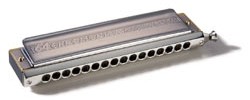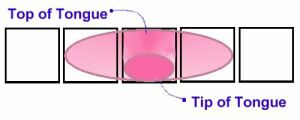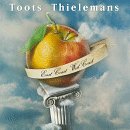

There are many harmonica techniques you can learn to add colours and texture to your pallet of self expression.
Playing octaves is when you play two notes that are a full octave apart.
Its a rewarding technique and usable in any key and the
the note layout of the chrom is perfect for this technique.
Octaves can add punch & richness to the higher register, and definition to the lower register.
The only exception to this is the right most draw note with the slide in,
as its octave counterpart is only four holes to the left.
There are three things to be aware of when learning octaves:
I have an average sized mouth for an adult male and up until now have found stretching over 5 holes very difficult to do.
I tried pushing the mouthpiece into my mouth deeply, but this left little room for holding the harp, slowed me down and was quite uncomfortable.
Eventually I figured that one way to make your mouth stretch is to SMILE,
using facial muscles to stretch the mouth wider. (gently now)
The more relaxed your lips and jaw the easier it becomes to do.
You may find your teeth clacking on the coverplates to begin with,
pull your lips just over the edge of your teeth to cusion them,
this improves embouchure seal too.
Having got all this, practise maintaining just the right stretch to cover exactly five holes
By the way, this is a very rich chord to play.
Work to stretch your mouth a little more or relax it a bit as you may be not getting all the holes, or getting too many. Keep this in mind as you work at getting clear octaves. With practice you'll train your body the correct setting to get an octave range.
Now you have the spread you're ready to work on getting two clean notes an octave apart. The trick was how to place my tongue over the holes I didn't want.
With tongue block the tongue is placed side onto the mouthpiece one way or the other. One technique that works is to use right or left tongue block normally, and then stretch your mouth just a little more on the opposite side to what you're playing.
However you can take a different approach by placing the tip of your tongue on the bottom of the the middle hole.
Push the front of your tongue against the three
holes gently leaving only the two end holes open to play.
Be gentle, experiment, practise and relax.

If you find you are getting a bit of a chord (usually unpleasant) it means you're not properly blocking the middle holes, or your embouchure is too wide, try concentrating your tongue a bit more to the offending side, and/or relax it more so it can spread wider over the holes.
This is like learning to play with tongue block all over again:
When shifting from hole to hole you want to avoid dragging your lips on the mouthpiece or covers and scraping your tongue along the hole edges.
This is part of why you need to maintain a relaxed attitude to your embouchure and keep your tongue relaxed,
so that as little effort as possible is required to shift from hole to hole.
Once again a moist mouthpiece allows your tongue and lips slide better along the harp.
However this is more difficult than simple tongue block because you also need to maintain your stretch over the five holes and blocking the middle holes just so.
If you find you are getting the wrong notes, stretch your mouth a little more or relax it a
bit you may be not getting all the holes, or getting too many.
Keeping it all together consistantly and on demand can only come from lots of practise. In my opinion this is definitely a worthwhile technique.
Some songs can be ornamented with an the occasional well placed trill on a holding note, or to punctuate a point in the song. To get a basic trill, rapidly but evenly press & release the button on the note you are playing.
When starting out practise getting an even in/out motion with the button. Speed will come as you practise this.
As you are gaining rapid motion if you are having difficulty getting smooth easy motion with the button, you can try using the pad of your index finger between the first and second knuckle.
These types of trills are just the beginning, and in truth are usually musically incorrect (out of key).
Musically correct trills work between two notes that lie on the scale you are playing in. To find all the variations a number of techniques & approaches are required, you can try flicking your jaw from one hole to the next. Perhaps its as easy as moving the harp into the button keeping the button still so the slide goes in as you change holes. Being very aware of where all the enharmonics are can be the difference between a choppy trill and a smooth trill. Using corner switching may be all thats required. As you become more and more familiar with your harmonica and where all the scales lie and the little tricks of getting from one note to another as effortlessly as possible using all the techniques here and more besides (be creative) you will find out little things that work for you. Being able to play all trills equally well is a long term goal, focusing on this will lead to being very familiar with your chromatic and playing across scales well.
It takes time and practise to get used to playing in different keys, and to co-ordinate the button slide changes at the correct time. So be patient with yourself, it'll come with time.
Vibrato is the slight, rapid and regular fluctuation in the pitch of a note.
Tremolo is variation in amplitude, taken to the extreme a rapid repitition of a note or rapid reiteration between two notes.
I know of three techniques other than hand tremolo using:
Tongue, throat and diaphragm.
Their difficulty to learn increases in respective order.
Good vibrato/tremolo is played in time (double time, quadruple time, or faster)
with the music you are playing.
Thankyou Bill Price for teaching me this technique.
Really simple to do. When you want to vary a long note go:
Thankyou Paul Farmer for teaching me this technique.
This takes some practise & developing but its quite doable with a months worth of practise.
Start by simple opening your mouth and using the back of your tongue against your throat to say
"K'...K'...K'..." like you're about to say "King" OR
"Gh...Gh...Gh..." like you're about to say "Goat" OR
"'ch...'ch...'ch" as in the "Lochness Monster".
Whatever works best for you. Try to keep a slow rhythm. Practise regularly.
When you can keep a constant rhythm going for a half minute or so its time to speed
to soften it so that the harsher part of the consonant is lost,
but without losing the definition of the vibrato.
As you keep practising try to increase your pace.
Increase it to a point where you're just about tripping up,
and keep at that for a week, and so forth.
You need to be well on your way developing
diaphragm (breath) control before attempting this.
Its a lightly controlled "pant pant pant..." using your diaphragm or gut
to create a tremolo.
This affects the note in a deep tonal way and is desirable for that.
Like throat vibrato its a matter of starting slowly and developing a rhythm and
practising to increase your speed and keeping rhythm whilst doing so.
Try using a metronome and panting in time with it.
Check in on Breathing Exercises
on the exercises page for working towards better strength and control.
 On a chromatic harmonica you can bend notes.
On a chromatic harmonica you can bend notes.
For example:
At the very least one can get a minimum of a semitone bend down from every single note on the chromatic harmonica. Having said that: often the top two or three holes are the hardest to bend as the reeds are generally very small at the top end. Sometimes they do not have valves making some of the bends simply unavailable. One can remedy this simply by adding soft windsavers to these holes.
The tongue technique is a good starting point for learning how to bend notes on the chrom. Once you have this technique working for you, then you can extend it into discovering how you are holding your mouth, tongue & throat and learning to hold the bent note without wavering. A lot of this is learnt by trial and error.
With valved bends only one reed is being effected, the other reed is stopped by a valve of course. Brendan Power, Stevie Wonder & William Galison sometimes remove some windsavers on their chromatics to allow bends that sound and act similar to bends available on short harp, which has a more gutteral tone since two reeds are interacting in such a bend. The quality of a valved bend sounds and feels different requiring a different approach and technique to bending short harps or unvalved chromatic.
A gentler touch is required with valved bends than with unvalved bends, as it takes less change in embouchure, less cavity area in the mouth to get the same range of pitch change. Valved reeds are more airtight by their nature and so are easier to play on a leakier chromatic than an unvalved bend. A leaky chromatic would make unvalved bends problematic. Once valved bending technique is learnt its readily available just as for those who learn how to bend notes unvalved.
The whole tongue tends to get involved with bends,
but more so with groove tongue & pucker unless one is working for using only the cough spot
(where you feel a cough starting).
If you are using tongue block, most of the work will be happening at the back of your throat
in the cough spot.
For high notes bent down you'll find it closing in reducing airspace,
on bending low notes down you'll find it opening up to increase airspace.
With groove tongue or pucker you ideally use the cough spot but may tend towards using the
back of your tongue in the 'K' spot (when pronouncing the letter 'K' its where you feel it
begin at the back of your throat. Again the principals are similar for bending notes,
the higher the note played the less airspace required, the lower the note, the more airspace required.
A lot of practise, observation, trying things out & patience will bring about results, blow bends & draw bends feel different,
and its quite a trick learning to control the bend so you don't end up choking the poor reed.
Again, less motion, less change in your embouchure for a valved bend compared to an unvalved bend (like on short harp). Approach gently and use a lighter and smaller changes when figuring this out.
The more leaky your harmonica the more control it will require from you.
At the time of writing Hering Chroms are easy to bend notes on because they
are built airtight and the reeds are soft making them very responsive.
Stock Hohner chromatics however require more puff to play therefore more
care & thought is required to acheive bends, yet Larry Adler played them bent a
lot of the time.